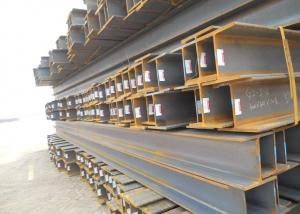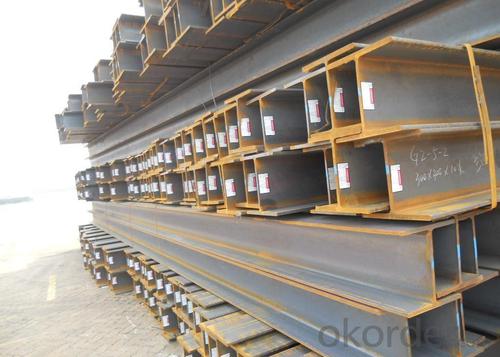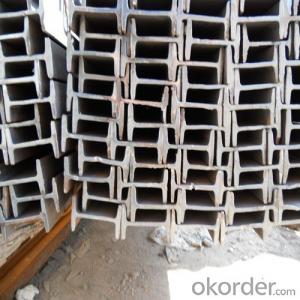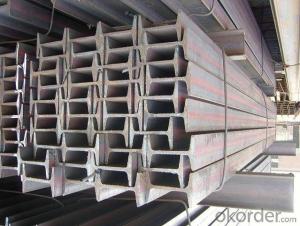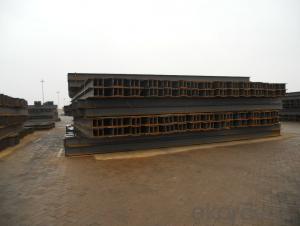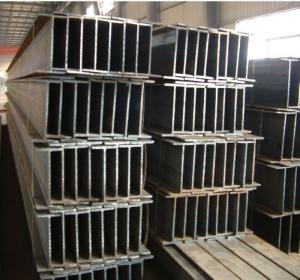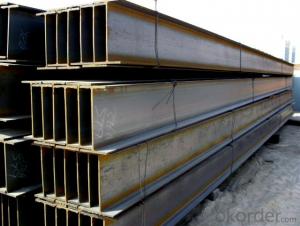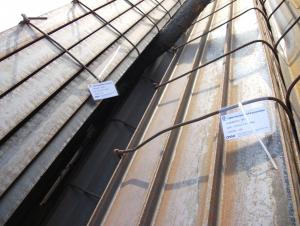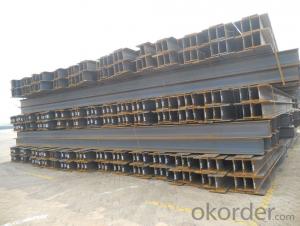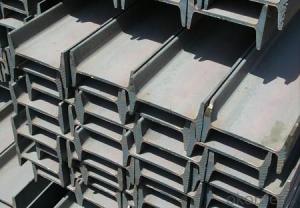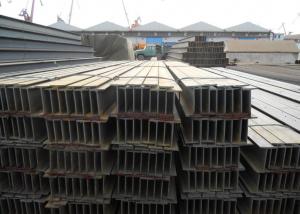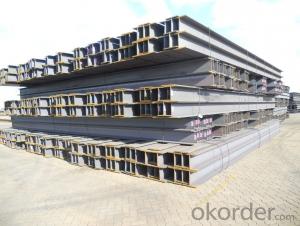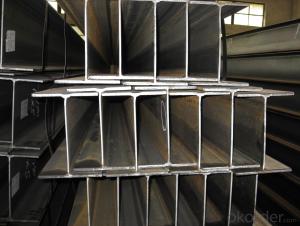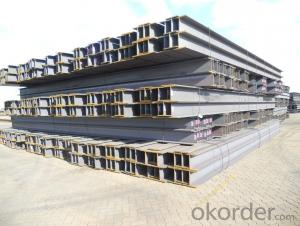Hot Rolled Steel H-beam
- Loading Port:
- China Main Port
- Payment Terms:
- TT or LC
- Min Order Qty:
- 100MT m.t.
- Supply Capability:
- 10000MT/MONTH m.t./month
OKorder Service Pledge
OKorder Financial Service
You Might Also Like
Specifications of Hot Rolled Steel H-beam For Sale
1. Standard: JIS
2. Grade: SS400
3. Length: 10m
4. Invoicing on theoretical weight or actual weight as customer request
5.Payment: TT or L/C
6. Sizes:
H x B
(mm)
| T1 | T2 | JIS Weight
(kg/m)
| GB Weight
(kg/m)
|
100*100 | 6 | 8 | 16.9 | 17.2 |
125*125 | 6.5 | 9 | 23.6 | 23.8 |
150*75 | 5 | 7 | 14 | 14.3 |
148*100 | 6 | 9 | 20.7 | 21.4 |
150*150 | 7 | 10 | 31.1 | 31.9 |
175*90 | 5 | 8 | 18 | 18.2 |
175*175 | 7.5 | 11 | 40.4 | 40.4 |
198*99 | 4.5 | 7 | 17.8 | 18.5 |
200*100 | 5.5 | 8 | 20.9 | 21.7 |
194*150 | 6 | 9 | 29.9 | 31.2 |
200*200 | 8 | 12 | 49.9 | 50.5 |
248*124 | 5 | 8 | 25.1 | 25.8 |
250*125 | 6 | 9 | 29 | 29.7 |
244*175 | 7 | 11 | 43.6 | 44.1 |
250*250 | 9 | 14 | 71.8 | 72.4 |
298*149 | 5.5 | 8 | 32 | 32.6 |
298*201 | 9 | 14 | 65.4 |
|
300*150 | 6.5 | 9 | 36.7 | 37.3 |
294*200 | 8 | 12 | 55.8 | 57.3 |
300*300 | 10 | 15 | 93 | 94.5 |
346*174 | 6 | 9 | 41.2 | 41.8 |
350*175 | 7 | 11 | 49.4 | 50 |
340*250 | 9 | 14 | 78.1 | 79.7 |
350*350 | 12 | 19 | 135 | 137 |
400*200 | 8 | 13 | 65.4 | 66 |
390*300 | 10 | 16 | 105 | 107 |
400*400 | 13 | 21 | 172 | 172 |
446*199 | 8 | 12 | 65.1 | 66.7 |
450*200 | 9 | 14 | 77.9 | 79.5 |
440*300 | 11 | 18 | 121 | 124 |
496*199 | 9 | 14 | 77.9 | 79.5 |
500*200 | 10 | 16 | 88.2 | 89.6 |
488*300 | 11 | 18 | 125 | 129 |
596*199 | 10 | 15 | 92.5 | 95.1 |
600*200 | 11 | 17 | 103.4 | 106 |
588*300 | 12 | 20 | 147 | 151 |
700*300 | 13 | 24 | 182 | 185 |
800*300 | 14 | 26 | 207 | 210 |
900*300 | 16 | 28 | 240.1 | 243 |
Usage & Applications of Hot Rolled Steel H-beam For Sale
Commercial building structure ;Pre-engineered buildings; Machinery support structure; Prefabricated structure; Medium scale bridges; Ship-building structure.etc.
Packaging & Delivery of Hot Rolled Steel H-beam For Sale
1. Packing: it is nude packed in bundles by steel wire rod
2. Bundle weight: not more than 3.5MT for bulk vessel; less than 3 MT for container load
3. Marks:
Color marking: There will be color marking on both end of the bundle for the cargo delivered by bulk vessel. That makes it easily to distinguish at the destination port.
Tag mark: there will be tag mark tied up on the bundles. The information usually including supplier logo and name, product name, made in China, shipping marks and other information request by the customer.
If loading by container the marking is not needed, but we will prepare it as customer request.
4. Transportation: the goods are delivered by truck from mill to loading port, the maximum quantity can be loaded is around 40MTs by each truck. If the order quantity cannot reach the full truck loaded, the transportation cost per ton will be little higher than full load.
5. Delivered by container or bulk vessel
Production flow of Hot Rolled Steel H-beam For Sale
Material prepare (billet) —heat up—rough rolling—precision rolling—cooling—packing—storage and transportation
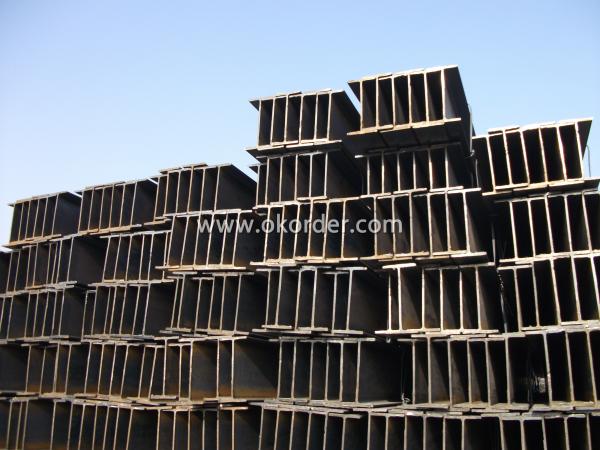
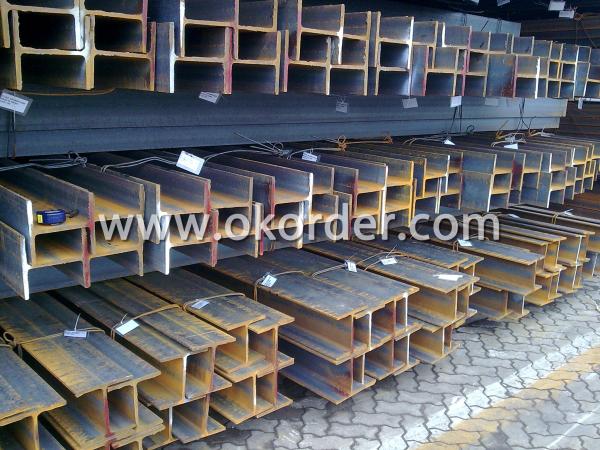
- Q: Can steel H-beams be used in utility infrastructure projects?
- Yes, steel H-beams can be used in utility infrastructure projects. They are commonly used in bridges, buildings, and other structures due to their strength, durability, and ability to support heavy loads. In utility projects, H-beams can be utilized for constructing support structures, such as transmission towers or substations, where strength and stability are crucial.
- Q: What are the load-bearing capacities of steel H-beams?
- The load-bearing capacities of steel H-beams vary depending on their size, shape, and material properties. H-beams are commonly used in construction and engineering projects due to their high strength and durability. The load-bearing capacity of a steel H-beam is primarily determined by its moment of inertia, which is a measure of its resistance to bending. The load-bearing capacity of a steel H-beam can be calculated using engineering formulas and considering factors such as the beam's cross-sectional area, material yield strength, and the applied load. The size and shape of the H-beam also play a crucial role in determining its load-bearing capacity. H-beams come in various sizes and weights, ranging from lightweight beams used in residential construction to heavy-duty beams used in commercial and industrial applications. To determine the load-bearing capacity of a specific steel H-beam, it is essential to consult the manufacturer's specifications or consult with a structural engineer. These professionals can provide detailed information about the specific load-bearing capacity of the H-beam based on its dimensions, material properties, and intended use. It is crucial to ensure that the chosen H-beam meets the required load-bearing capacity to ensure the structural integrity and safety of the project.
- Q: Can steel H-beams be used for utility poles?
- No, steel H-beams cannot be used for utility poles. Utility poles are typically made of wood or sometimes concrete, as these materials have certain properties that make them more suitable for this purpose. Wood is lightweight, easy to work with, and provides good insulation against electricity. Concrete poles are durable, resistant to weather conditions, and have a longer lifespan than wood poles. Steel H-beams, on the other hand, are primarily used in construction for structural support, such as in buildings and bridges. While they are strong and can bear heavy loads, they are not designed to withstand the specific requirements of utility poles, such as electrical insulation and resistance to rot and decay. Therefore, it is not recommended to use steel H-beams for utility poles.
- Q: Can steel H-beams be used in historical restoration projects?
- Yes, steel H-beams can be used in historical restoration projects. They offer structural stability and durability, making them a suitable choice for reinforcing or replacing deteriorated beams in historic structures. However, it's essential to ensure that the use of steel H-beams aligns with the preservation goals and guidelines of the specific historical restoration project.
- Q: Light thin-walled H steel, in addition to welding, is there any hot rolling?
- Yes, the 2 largest domestic hot-rolled H steel producers are Laiwu Steel and Maanshan Iron and steel
- Q: Are Steel H-Beams suitable for theater or performing arts center construction?
- Yes, Steel H-Beams are suitable for theater or performing arts center construction. Steel H-Beams are commonly used in the construction industry due to their strength and durability. They provide excellent support and structural integrity, making them ideal for large-scale projects like theaters or performing arts centers. The H-Beam's shape allows it to distribute weight evenly, minimizing the risk of structural failure. Additionally, steel is fire-resistant, which is crucial for buildings where large crowds gather. Moreover, steel H-Beams can be easily fabricated and installed, making the construction process more efficient. Overall, steel H-Beams offer the necessary strength and stability required for theater or performing arts center construction.
- Q: How do Steel H-Beams compare to other structural beams, such as I-beams or wood beams?
- Steel H-beams have several advantages compared to other structural beams. Firstly, they have a higher strength-to-weight ratio, meaning they can support heavier loads with less material. Secondly, their shape provides increased structural stability, making them more resistant to bending or twisting. Additionally, steel H-beams have better fire resistance than wood beams and are not susceptible to rot or pests. Overall, steel H-beams are a preferred choice for structural applications due to their superior strength, stability, and durability.
- Q: How do steel H-beams contribute to the stability of tall buildings?
- Steel H-beams contribute to the stability of tall buildings by providing a strong and rigid structural framework. These beams are designed to withstand high loads and forces, such as the weight of the building and wind or seismic forces. By distributing the load evenly across multiple H-beams, they help to prevent excessive deflection and ensure the building remains stable even under extreme conditions. Additionally, the use of steel H-beams allows for flexible and efficient construction, enabling architects and engineers to design taller and more complex buildings.
- Q: How do you calculate the flexural rigidity of steel H-beams?
- To calculate the flexural rigidity of steel H-beams, you need to know the dimensions and material properties of the beam. The flexural rigidity, also known as the bending stiffness, measures a beam's resistance to bending under an applied load. The formula to calculate the flexural rigidity of a beam is: EI = (1/3) * E * I Where: - EI is the flexural rigidity - E is the modulus of elasticity of the material - I is the moment of inertia of the beam's cross-sectional shape To determine the moment of inertia, you need to know the dimensions of the beam's cross-section. For an H-beam, this typically includes the width of the flanges, the depth of the web, and the thickness of the flanges and web. Once you have the dimensions, you can calculate the moment of inertia using the appropriate formula for an H-beam. The moment of inertia is a measure of an object's resistance to changes in its rotational motion about a particular axis. Finally, you need to know the modulus of elasticity of the steel material. This is a measure of the stiffness of the material, indicating how it responds to applied forces. By substituting the values of E and I into the formula, you can calculate the flexural rigidity of the steel H-beam. It is worth noting that the flexural rigidity can vary depending on the specific steel grade and any additional factors, such as material defects or temperature variations. Therefore, it is essential to use accurate and up-to-date material properties for precise calculations. Consulting relevant engineering standards or seeking professional advice can help ensure accurate results.
- Q: How do Steel H-Beams perform in seismic or high-wind conditions?
- Both seismic and high-wind conditions are situations where Steel H-Beams excel. These beams are specifically designed to endure the forces exerted during earthquakes and strong winds, making them the preferred option for structural applications in areas that are susceptible to such events. In seismic conditions, Steel H-Beams are highly effective due to their inherent strength and flexibility. Their H-shape design enhances their resistance against lateral forces, allowing them to distribute and dissipate the energy produced by earthquake vibrations. This minimizes damage to the overall structure and enhances the safety of the building and its occupants. Similarly, Steel H-Beams perform exceptionally well in high-wind conditions. Their structural properties, such as their high strength-to-weight ratio and rigidity, enable them to withstand strong wind loads. The H-Beams' shape efficiently transfers wind forces to the foundation, preventing excessive movement and ensuring structural stability. Furthermore, the performance of Steel H-Beams in seismic or high-wind conditions can be further improved through various methods. Reinforcing the beams with additional steel plates, using higher-grade steel, or implementing advanced connection details can all contribute to increased resilience and reliability. Overall, Steel H-Beams are a dependable choice for construction projects in areas prone to seismic or high-wind conditions. Their ability to withstand and dissipate forces generated by earthquakes or strong winds makes them an ideal structural element, guaranteeing the safety and durability of buildings in challenging environments.
1. Manufacturer Overview
| Location | Tangshan, China |
| Year Established | 2007 |
| Annual Output Value | Above US$ 80 Million |
| Main Markets | Mid East; Southeast aisa; korea |
| Company Certifications |
2. Manufacturer Certificates
| a) Certification Name | |
| Range | |
| Reference | |
| Validity Period |
3. Manufacturer Capability
| a) Trade Capacity | |
| Nearest Port | Tianjin; |
| Export Percentage | 20% - 25% |
| No.of Employees in Trade Department | 11-15 People |
| Language Spoken: | English; Chinese |
| b) Factory Information | |
| Factory Size: | Above 75,000 square meters |
| No. of Production Lines | 1 |
| Contract Manufacturing | OEM Service Offered; |
| Product Price Range | Average |
Send your message to us
Hot Rolled Steel H-beam
- Loading Port:
- China Main Port
- Payment Terms:
- TT or LC
- Min Order Qty:
- 100MT m.t.
- Supply Capability:
- 10000MT/MONTH m.t./month
OKorder Service Pledge
OKorder Financial Service
Similar products
Hot products
Hot Searches
Related keywords
